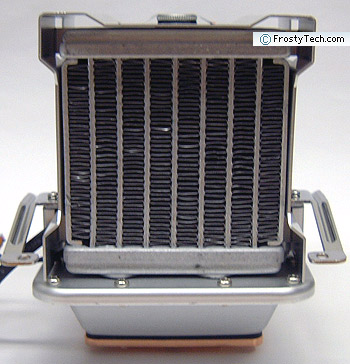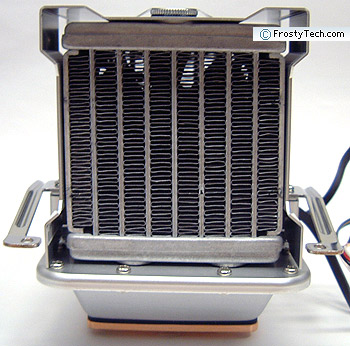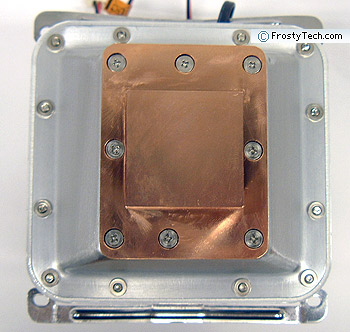
|
|
74%
Abstract: The Xigmatek AIO-S80DP is both a new
approach to watercooling, and the first salvo from an entirely new heatsink manufacturer.
|
Home >
Reviews >
Page: 360° View - Xigmatek AIO-S80DP heatsink Heatsink
|
360° View - Xigmatek AIO-S80DP
Heatsink
Information on Frostytech's test
methodology is available here.
| |
|
 |
The Heatsink Fan:
Under
the sticker that says "Warranty
Void if Removed" is the cap for the radiator, where a mixture of water,
anti-corrosive and antifreeze has been blended to create a coolant
which will hopefully resist corrosion and bacteria growth over
the years. Since there are basically only rubber O-ring seals on the Xigmatek
heatsink, loss of working fluid by vapour transmission loss isn't as
much of a worry as if the system were using rubber tubing. An 80x80x25mm
fan is hidden under the aluminum shell of the AIO-S80DP heatsink,
and it draws air through one heat exchanger before blowing it out
through a second heat exchanger. Noise levels hover around the 55.0 dBA
mark at stock fan speeds. The fan connects via a 4-pin PWM
compliant motherboard fan header, and the small 12V pump by a 3-pin
power cable. The pump doesn't generate an audible noise
signature. |
 |
Heatsink Top
Uncovered:
Each brazed aluminum radiator is 22x80x87mm in size. The 80mm PWM
fan sits in between each of the radiators, with a 15mm plenum on either side. The
pump is permanently set into the base of the AIO-S80DP, where it pushes 72 L/hr of coolant around. The
pump connects via its own power cord to any 3-pin motherboard fan header, or uses an included molex
power adaptor. The aluminum radiators sit 48mm apart from each other. |
 |
Heatsink Side
A:
The radiator is made from brazed aluminum
sections, and occupies an effective space of about 80x80mm in area.
Very thin aluminum fins connect fluid passages, and this is what allows the heat from
the coolant inside to be transferred to the surrounding environment. Under the cap is a clear antifreeze
coolant. The vertical fluid channels are 2mm thick, spaced 7.5mm apart. The fine aluminum fins are spaced a
little over 1.3mm apart so as not to restrict airflow significantly. |
 |
Heatsink Side B:
The opposite side of the
Xigmatek AIO-S80DP heatsink is identical. The trapezoidal shaped aluminum base is 36mm tall,
and acts as the reservoir for holding cooling fluid. The pump is supported in this tank directly
over the copper base plate, which is visible at the very bottom. The aluminum
tank, and joints between the aluminum and copper are both sealed water tight with
rubber washers. |
 |
Heatsink Side C:
From the opposite side, the fan shroud is
all that's visible. Note the springy metal mounting clips which come
pre-attached to the Xigmatek AIO-S80DP heatsink. Screws are
used to firmly attach the cooler
to one of the three sets of mounting brackets, and in turn apply the
necessary pressure to the CPU below. The fan is mounted to the fan
shroud at the top, as you can see from the cut out. During
our tests, high resonance vibrations between the aluminum shroud and the
rest of the heatsink were audible. Adjusting the tension on the
screws which hold the shroud to the heatsink made the resonance disappear. The
Xigmatek AIO-S80DP heatsink stands 131mm tall. At its widest point, the heatsink is 103mm
wide.
|
 |
Heatsink Base:
The copper base of the Xigmatek AIO-S80DP
heatsink is fully machined, and the portion which makes contact with
the CPU measures 37 x 37mm (overall size is 70x54mm).
The base is at least 6.5mm thick, and
it's safe to assume it extends into the
body of the reservoir about 10mm or so. The base is perfectly flat
in both axis, with a smooth CNC machined finish. Surface roughness is
on the order of ~8 microinches, which is considered excellent. There is a rubber
gasket between the copper base (held on with eight screws) and
aluminum reservoir. Xigmatek used steel thread inserts to ensure the lower
half of the aluminum reservoir remains firmly attached to the upper plate; in
general build quality of the Xigmatek AIO-S80DP heatsink is
excellent. |
|
 |
Websites you may also like:
PCSTATS
|
|
 |


